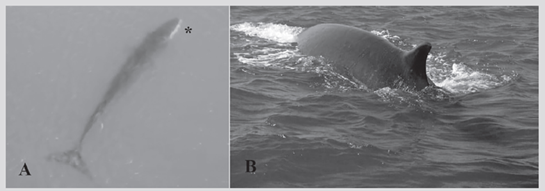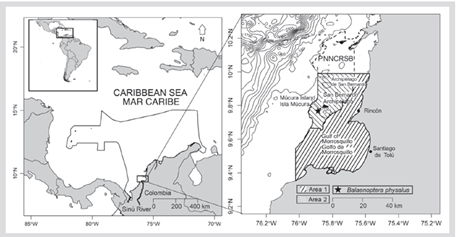Fin whales (Balaenoptera physalus), the second largest species within the Balaenopteridae family, are often considered as having a cosmopolitan distribution (Aguilar and García-Vernet, 2018). Nonetheless, sightings and literature records show a scarce occupation of tropical waters (Edwards et al., 2015). There are only three records of live individuals for Colombia, both from the Pacific Ocean (Vidal, 1990; Palacios et al., 2012). Additionally, the skeleton of a specimen recovered from the Caribbean was kept at the Sea Museum of Jorge Tadeo Lozano University (Prieto-Rodríguez, 1988).
Between January 23rd and 27th, 2020, the community of Puerto Caracol along with tourism operators of the San Bernardo Archipelago reported a whale near Múcura Island, within the jurisdiction of the Rosario and San Bernardo Corals National Natural Park (PNNCRSB). PNNCRSB is a marine protected area under the jurisdiction of the Tourism and Culture District of Cartagena with an approximate extension of 120 000 ha (Zarza-González, 2011). This area holds ecosystems of considerable biodiversity including coral reefs, seagrasses, sedimentary bottoms, tropical dry forest, coastal lagoons and rocky and sandy coastlines (Flórez and Etter, 2003; Zarza-González, 2011). The continental shelf within the jurisdiction of the PNNCRSB extends over 30 km from the coastline and is characterized by plain terrains and irregular submarine landscapes with depths that range between 60 and 110 m (Morales and Idárraga-García, 2013).
On January 23rd, the community of Puerto Caracol and personnel from PNNCRSB received technical support from Fundación Macuáticos Colombia and Fundación Tortugas de Mar for the organization of a boat group that tried to drive the whale offshore, since it was occupying waters approximately 15 m deep, which represented a risk for stranding. Nonetheless, the whale often returned to shallow waters, presumably because of the presence of schools of herring, according to fishermen reports. The next day, a tourism operator and several fishermen managed to film it, where slow traveling near the water surface can be seen. The video also revealed a considerable distance between the blowhole and the dorsal fin, which is falcate and located within the last third of the whale’s body. Additionally, a dark coloration, almost black, was also noted (Figure 1). From that moment on, the team at PNNCRSB along with the Coast Guard completed actions of control, vigilance and socialization of the responsible sighting guide for aquatic mammals in Colombia (MinAmbiente, 2017) in order to avoid any negative impacts on the animal.

Figure 1 Diagnostic characters for the taxonomic identification of Fin whales. A) Asymmetrical pigmentation of the jaw, indicated by an asterisk (*). B) small and backward-sloping dorsal fin, located in the last third of the body. Photographs: A) Fundación Sueños de Mar. B) PNNCRSB.
During the third consecutive day of sighting, the fishermen and the team from PNNCRSB reported the whale on waters of herring abundance. While it was not possible to collect a herring specimen, so the species was not identified, the common herring (Sardinella aurita) and the thread herring (Ophistonema oglinum) are suggested as possible candidates. On January 26th, members of Fundación Sueños de Mar along with officers from PNNCRSB managed to deploy a drone and film the whale’s slow and shallow cruising behavior. The video also allowed the detection of the asymmetrical head pigmentation, with a lighter gray on the dorsal surface and white towards the lower jaw, diagnostic features for Fin whales (Balaenoptera physalus) (Aguilar and García-Vernet, 2018; Figure 1). In the context of this sighting, it was possible to geo-reference the location of the individual with a GPS unit (9º 46′ 22.0″ N-75º 52′ 53.3″ W). Finally, on January 27th, 2020, locals only saw the whale in the morning, despite the fact that the Coast Guard was monitoring the area searching for signals that will alert about its presence.
The whale was located one kilometer away from Múcura Island and 26 km from the coastline (Figure 2). At this point depth was estimated at 82 m thanks to the GEBCO database (2020), available with a resolution of 450 × 450 m. Additionally, and in order to contextualize the oceanographic and environmental conditions during the week in which sightings occurred, bathymetry, sea surface temperature, and superficial concentrations of chlorophyll a and particulate organic carbon were estimated for two polygons: one that included the Gulf of Morrosquillo, and particularly the area of influence of Sinú River mouth (Area 1 within Figure 2) and a second one, which was specific to the southern section of PNNCRSB around the georeferenced location of the individual (Area 2 within Figure 2). Superficial concentrations of chlorophyll a, particulated organic carbon and sea surface temperature data were accessed based on an eight day composite and with a spatial resolution of 4 × 4 km through the Ocean Color web platform (NASA 2014, 2018a, 2018b) in netCDF4 format. For the southern section of PNNCRSB, concentration of chlorophyll a reported between January 17th and 24th, 2020, ranged between 0.2 and 1.21 mg/m3, with an average of 0.43 mg/m3, while the concentration of particulate organic carbon ranged between 74.8 and 249.8 mg/m3, with an average of 133.5 mg/m3. Sea surface temperature oscillated between 28.8 and 29.3 °C, with an average of 29 °C. Finally, bathymetry ranged between -220 m and the coastline of Múcura Island, with an average of -61 m. On the other hand, for the zone of influence of the Sinú River mouth, concentration of chlorophyll a reported between January 17th and 25th, 2020, ranged between 0.2 and 5.5 mg/m3, with an average of 1.24 mg/m3, while the concentration of particulated organic carbon ranged between 67.6 and 419.4 mg/m3, with an average of 216.5 mg/m3. In addition, sea surface temperature oscillated between 29.2 and 30.4 °C, with an average of 29.6 °C. Finally, bathymetry ranged between -80 m and the coastline of the Gulf of Morrosquillo, with an average of -23 m. Environmental data manipulation and the extraction of averages and minimum/maximum values for each polygon were performed using raster (Hijmans 2017) and rgdal (Bivand et al., 2018) packages implemented in R v. 3.5.2 (R Core Team 2018).

Figure 2 Geographic location of the Fin whale within jurisdiction of the Rosario and San Bernardo Corals National Natural Park (PNNCRSB) on January 26th, 2020. The right panel represents the Colombian Economic Exclusive Zone in the Caribbean, while PNNCRSB jurisdiction is shown with the dotted line on the left panel.
Traditionally, the Colombian Caribbean is considered to be an oligotrophic and homogeneous ecosystem (Arévalo-Martínez and Franco-Herrera, 2008; Rueda-Roa and Müller-Karger, 2013). This, it is presumed, has a considerable impact on cetacean abundance and diversity (Barragán-Barrera et al., 2019). Nonetheless, due to sediment discharge from the Amazon, Orinoco and Sinú rivers, as well as the occurrence of seasonal upwellings associated with the northern trade winds between January and April, there are peaks in productivity per year that could eventually allow the occasional presence of species such as the Fin whale, which require a considerable quantity of highly caloric resources (Rueda-Roa and Müller-Karger, 2013; Aguilar and García-Vernet, 2018).
In spite of reports indicating that euphausiids would be the main prey of Fin whales (Mizrock et al., 1984; Tershy, 1992; Aguilar y García-Vernet, 2018), the species has shown considerable diet flexibility, exploiting school fish in an opportunistic matter (Kawamura, 1980; Tershy, 1992; Gendron, 1993; Woodley and Gaskin, 1996; Gendron et al., 2001). Even though it was not possible to observe surface feeding behavior (e.g. open mouth, engulfment or distension of ventral plates); slow and superficial traveling, as well as prolonged dives, have been suggested as indicators of foraging and feeding (Watkins, 1981; Panigada et al., 2003). In addition, fishermen consistently indicated abundance of herrings during sightings, which could support the hypothesis of opportunistic feeding.
The current report constitutes the first of a living specimen of Fin whale in the Colombian Caribbean. While it has been suggested that the species rarely occupies waters between 20° N and 20° S (Edwards et al., 2015; Aguilar and García-Vernet, 2018; García-Rivas et al., 2019), which includes the Colombian Caribbean, the sighting near the San Bernardo Archipelago suggests that while such geographic range can include a lower abundance of the species, the waters of the Colombian Caribbean could be part of the distribution range of Fin whales, at least in a secondary way.
It is important to highlight the relevance of citizen and participative science, besides interinstitutional and collaborative work within scientific and environmental institutions, which are vital to overcome information gaps (Boney et al., 2009). Considering the current record, it is particularly important to support programs and initiatives of scientific research in order to provide feedback for environmental education activities within the local communities, particularly those that prioritize knowledge dialogue processes.











 text in
text in 



